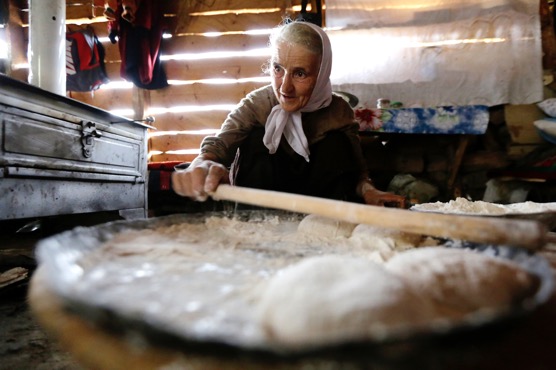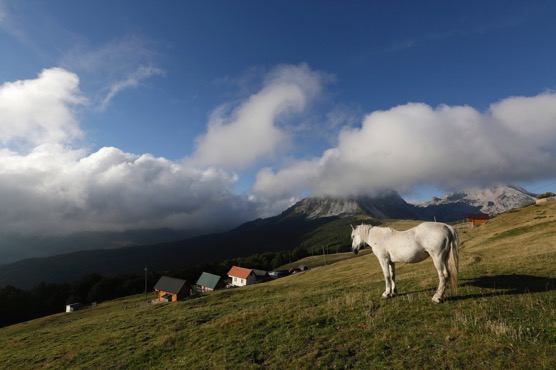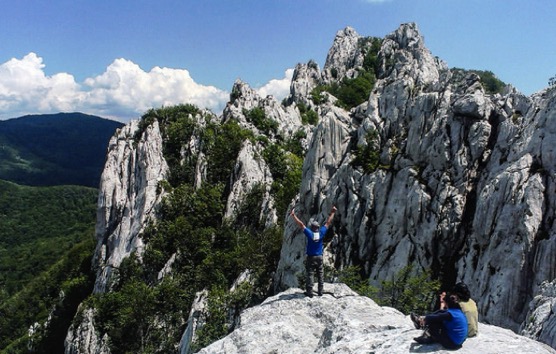Travel Redux in Southeastern Europe
Photos: Elma OkicA herd of sheep, in need of sheering, stiffened and crowded together as we approached from over the pass. Their shepherd sat on a rock and smoked a cigarette. From time to time he popped a switch against the rock and called out to the shaggy congregation. They looked up, stared blankly and then pointed their snouts back into the green grass.
When we told the shepherd where we were headed—to the tri-border point where Albania, Montenegro, and Kosovo meet—he paused and lit another cigarette. It was summer but he wore a wool sweater and dark trousers. He told us that the next pass was two hours away. He pointed his switch across the expanse toward a 7,000-foot mountain wall, where pockets of snow still sat in crags—the backdrop for this natural amphitheater.
Stone houses, cobbled and re-cobbled over centuries, stood watch over sections of the meadow. Each had a 10-foot-high haystack. Wooden pitchforks leaned against the carefully shaped mounds. The plots of land were delineated with ancient wooden fences: tree branches twisted and woven together. As we passed, residents stood and waved—happy for the brief company. Some offered coffee. We drank raki, an Albanian liqueur, with one family. After two shot glasses of the elixir, the father told us that he believed the pass was three hours away.
On the surface, there was nothing inherently odd about walking across that field in northeast Albania, an area known as the Albanian Alps. For hikers in Europe—especially in the more familiar Western Alps—the scene, though more rustic, is a familiar one. What was odd is that just 25 years ago not only would foreign trekkers be unheard of, their existence here, which was still under the grip of a 45-year dictatorial regime, would have been tantamount to espionage.

![]()
The power of tourism and travel to reinvent previously unexplored regions of the world was not lost on our group as we walked across the Balkan Peninsula in Southeastern Europe last summer on a brand new “mega” hiking trail called the Via Dinarica. The trail follows the highest peaks along the Dinaric Alps range and incorporates the regional massifs that are immediately tangent. In fact, the very purpose of our trek was to encourage that reinvention. The route connects the countries of the Balkans’ western half—portions of which were embroiled in war less than 20 years earlier—in a way not thought possible: peacefully, naturally, and with a sense of cross-cultural cooperation. The path includes, from north to south, Slovenia, Croatia, Bosnia and Herzegovina, Serbia, Montenegro, Albania, Kosovo, and Macedonia.

The purpose of the trail is to act as a vehicle for adventure tourism and as a corridor linking some of Europe’s last remaining Old World culture. This corridor has the potential to serve as a business engine, in a part of the world that has natural resources in spades.
But the all-important word here is cooperation. This region has seen its share of well-documented conflict and hardship. But, the hoped-for result of this trail is to highlight one of the most beautiful, unheralded, and unspoiled stretches of land on the continent. By coming together with a sense of camaraderie, countries have put aside decades of strife and differences and now work in harmony to host travelers and show off similarities, namely unspoiled, rugged landscapes and ancient culture.
Driving this point of reinvention home one step further, the trail runs through the heart of the National Geographic Western Balkans Geotourism Mapguide Network of countries. The collaboration codifies a style of tourism that places the destination and the preservation of its authenticity as the highest ideals. The Western Balkans Network includes Albania, Bosnia and Herzegovina, Kosovo, Macedonia, Montenegro, and Serbia.
-

-

-

-

-

-

-

-

-

-

-

-

-

-

-

-

-

-

-

-

-

-

-

-

-

-

-

-

-

-

-

-

-

-

-

-

-

-

-

-










































